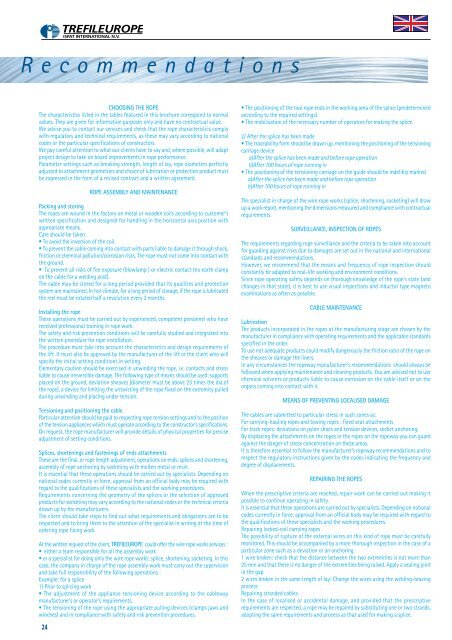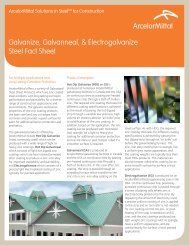INTERIEUR - Mittal Steel
INTERIEUR - Mittal Steel
INTERIEUR - Mittal Steel
You also want an ePaper? Increase the reach of your titles
YUMPU automatically turns print PDFs into web optimized ePapers that Google loves.
24<br />
TREFILEUROPE<br />
ISPAT INTERNATIONAL N.V.<br />
Recommendations<br />
CHOOSING THE ROPE<br />
The characteristics listed in the tables featured in this brochure correspond to normal<br />
values. They are given for information purposes only and have no contractual value.<br />
We advise you to contact our services and check that the rope characteristics comply<br />
with regulatory and technical requirements, as these may vary according to national<br />
codes or the particular specifications of constructors.<br />
We pay careful attention to what our clients have to say and, where possible, will adapt<br />
project design to take on board improvements in rope performance.<br />
Parameter settings such as breaking strength, length of lay, rope diameters perfectly<br />
adjusted to attachment geometries and choice of lubrication or protection product must<br />
be expressed in the form of a revised contract and a written agreement.<br />
ROPE ASSEMBLY AND MAINTENANCE<br />
Packing and storing<br />
The ropes are wound in the factory on metal or wooden coils according to customer's<br />
written specification and designed for handling in the horizontal axis position with<br />
appropriate means.<br />
Care should be taken:<br />
• To avoid the inversion of the coil.<br />
• To prevent the cable coming into contact with parts liable to damage it through shock,<br />
friction or chemical pollution/corrosion risks. The rope must not come into contact with<br />
the ground.<br />
• To prevent all risks of fire exposure (blowlamp ) or electric contact (no earth clamp<br />
on the cable for a welding post).<br />
The cable may be stored for a long period provided that its qualities and protection<br />
system are maintained. In hot climate, for a long period of storage, if the rope is lubricated<br />
the reel must be rotated half a revolution every 3 months.<br />
Installing the rope<br />
These operations must be carried out by experienced, competent personnel who have<br />
received professional training in rope work.<br />
The safety and risk prevention conditions will be carefully studied and integrated into<br />
the written procedure for rope installation.<br />
The procedure must take into account the characteristics and design requirements of<br />
the lift. It must also be approved by the manufacturer of the lift or the client who will<br />
specify the initial setting conditions in writing.<br />
Elementary caution should be exercised in unwinding the rope, i.e. contacts and stress<br />
liable to cause irreversible damage. The following type of means should be used: supports<br />
placed on the ground, deviation sheaves (diameter must be above 25 times the dia.of<br />
the rope), a device for limiting the untwisting of the rope fixed on the extremity pulled<br />
during unwinding and placing under tension.<br />
Tensioning and positioning the cable<br />
Particular attention should be paid to respecting rope tension settings and to the position<br />
of the tension appliances which must operate according to the constructor’s specifications.<br />
On request, the rope manufacturer will provide details of physical properties for precise<br />
adjustment of setting conditions.<br />
Splices, shortenings and fastenings of ends attachments<br />
These are the final, or rope length adjustment, operations on ends: splices and shortening,<br />
assembly of rope anchoring by socketing with molten metal or resin.<br />
It is essential that these operations should be carried out by specialists. Depending on<br />
national codes currently in force, approval from an official body may be required with<br />
regard to the qualifications of these specialists and the working procedures.<br />
Requirements concerning the geometry of the splices or the selection of approved<br />
products for socketing may vary according to the national codes or the technical criteria<br />
drawn up by the manufacturers.<br />
The client should take steps to find out what requirements and obligations are to be<br />
respected and to bring them to the attention of the specialist in writing at the time of<br />
ordering rope fixing work.<br />
At the written request of the client, TREFILEUROPE could offer the wire rope works services :<br />
• either a team responsible for all the assembly work<br />
• or a specialist for doing only the wire rope works; splice, shortening, socketing. In this<br />
case, the company in charge of the rope assembly work must carry out the supervision<br />
and take full responsibility of the following operations :<br />
Example: for a splice<br />
1/ Prior to splicing work<br />
• The adjustment of the appliance tensioning device according to the cableway<br />
manufacturer’s or operator's requirements.<br />
• The tensioning of the rope using the appropriate pulling devices (clamps jaws and<br />
winches) and in compliance with safety and risk prevention procedures.<br />
• The positioning of the two rope ends in the working area of the splice (predetermined<br />
according to the required settings).<br />
• The mobilisation of the necessary number of operators for making the splice.<br />
2/ After the splice has been made<br />
• The traceability form should be drawn up, mentioning the positioning of the tensioning<br />
carriage device<br />
a)After the splice has been made and before rope operation<br />
b)After 100 hours of rope running in<br />
• The positioning of the tensioning carriage on the guide should be indelibly marked<br />
a)After the splice has been made and before rope operation<br />
b)After 100 hours of rope running in<br />
The specialist in charge of the wire rope works (splice, shortening, socketing) will draw<br />
up a work report, mentioning the dimensions measured and compliance with contractual<br />
requirements.<br />
SURVEILLANCE, INSPECTION OF ROPES<br />
The requirements regarding rope surveillance and the criteria to be taken into account<br />
for guarding against risks due to damages are set out in the national and international<br />
standards and recommendations.<br />
However, we recommend that the means and frequency of rope inspection should<br />
constantly be adapted to real-life working and environment conditions.<br />
Since rope operating safety depends on thorough knowledge of the rope’s state (and<br />
changes in that state), it is best to use visual inspections and inductor type magneto<br />
examinations as often as possible.<br />
CABLE MAINTENANCE<br />
Lubrication<br />
The products incorporated in the ropes at the manufacturing stage are chosen by the<br />
manufacturer in compliance with operating requirements and the applicable standards<br />
specified in the order.<br />
To use not adequate products could modify dangerously the friction ratio of the rope on<br />
the sheaves or damage the liners.<br />
In any circumstances the ropeway manufacturer’s recommendations should always be<br />
followed when applying maintenance and cleaning products. You are advised not to use<br />
chemical solvents or products liable to cause corrosion on the cable itself or on the<br />
organs coming into contact with it.<br />
MEANS OF PREVENTING LOCALISED DAMAGE<br />
The cables are submitted to particular stress in such zones as:<br />
For carrying-hauling ropes and towing ropes : fixed seat attachments<br />
For track ropes: deviations on pylon shoes and tension devices, socket anchoring.<br />
By displacing the attachments on the ropes or the ropes on the ropeway you can guard<br />
against the danger of stress concentration on these areas.<br />
It is therefore essential to follow the manufacturer’s ropeway recommendations and to<br />
respect the regulatory instructions given by the codes indicating the frequency and<br />
degree of displacements.<br />
REPAIRING THE ROPES<br />
When the prescriptive criteria are reached, repair work can be carried out making it<br />
possible to continue operating in safety.<br />
It is essential that these operations are carried out by specialists. Depending on national<br />
codes currently in force, approval from an official body may be required with regard to<br />
the qualifications of these specialists and the working procedures.<br />
Repairing locked-coil carrying ropes<br />
The possibility of rupture of the external wires on this kind of rope must be carefully<br />
monitored. This should be accompanied by a more thorough inspection in the case of a<br />
particular zone such as a deviation or an anchoring.<br />
1 wire broken: check that the distance between the two extremities is not more than<br />
25 mm and that there is no danger of the extremities being raised. Apply a sealing joint<br />
in the gap.<br />
2 wires broken in the same length of lay: Change the wires using the welding-brazing<br />
process<br />
Repairing stranded cables<br />
In the case of localised or accidental damage, and provided that the prescriptive<br />
requirements are respected, a rope may be repaired by substituting one or two strands,<br />
adopting the same requirements and process as that used for making a splice.



